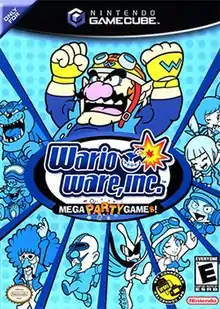WarioWare, Inc.: Mega Party Games!
WarioWare, Inc.: Mega Party Game$![lower-alpha 1] is a party video game for the GameCube. A remake of WarioWare, Inc.: Mega Microgames!, and the second installment in the WarioWare series, the game translates the "microgame" gameplay of Mega Microgames! to be playable in a multiplayer environment. It comes with eight special multiplayer modes for up to four players that all involve the known microgames in some way.
| WarioWare, Inc.: Mega Party Games! | |
|---|---|
 North American box art | |
| Developer(s) | Intelligent Systems Nintendo R&D1 |
| Publisher(s) | Nintendo |
| Director(s) | Goro Abe Osamu Yamauchi |
| Producer(s) | Takehiro Izushi Ryoichi Kitanishi |
| Artist(s) | Ko Takeuchi |
| Composer(s) | Masanobu Matsunaga Kenichi Nishimaki |
| Series | Wario |
| Platform(s) | GameCube |
| Release | |
| Genre(s) | Party game |
| Mode(s) | Single-player, multiplayer |
Gameplay
Its gameplay shares elements with other WarioWare titles, emphasising quick consecutive minigames for the player to complete (dubbed by the game as "microgames"), but focuses more on multiplayer than other games in the series.[1] Many of the microgames are taken from the original WarioWare, Inc.: Mega Microgames![2]
Development
The game was developed by Intelligent Systems and Nintendo Research & Development 1, and published worldwide by Nintendo in October 2003 in Japan, and a year later in April for North America and in September for Europe.[3][4][5][6] The game was produced by Takehiro Izushi and Ryoichi Kitanishi, directed by Goro Abe and Osamu Yamauchi and composed by Masanobu Matsunaga and Kenichi Nishimaki.[7]
Reception
Mega Party Games! received generally favorable reviews upon release, with reviewers commonly citing the game's multiplayer appeal as a positive, but its copied material from Mega Microgames! as a negative.[8] GameRankings gave the game an aggregated score of 77% based on 53 reviews.[9] The game is the first in the series to introduce a focus of multiplayer, a theme that would not be re-visited by the series until the console sequel WarioWare: Smooth Moves on the Wii in 2006.[10] During the 8th Annual Interactive Achievement Awards, WarioWare, Inc.: Mega Party Games! received a nomination for "Console Family Game of the Year" by the Academy of Interactive Arts & Sciences.[11]
| Aggregator | Score |
|---|---|
| GameRankings | 77% |
| Metacritic | 76/100[12] |
| Publication | Score |
|---|---|
| Eurogamer | 7/10[13] |
| IGN | 7.5/10[14] |
| Nintendo World Report | 8.5/10[15] |
Notes
- Known in Japan as Atsumare!! Made in Wario (あつまれ!!メイド イン ワリオ, literally Gather!! Made in Wario), stylized as WarioWare, Inc.: Mega Party Game$!.
References
- Arushan, Zosha (2 May 2004). "Wario Ware, Inc.: Mega Party Game$". Nintendo World Report. Retrieved 7 August 2018.
- "Mobygames WarioWare, Inc.: Mega Party Games! description". Retrieved 22 September 2022.
- "Japanese game update". GameSpot. Retrieved 2023-04-29.
- "Slew of new Nintendo info". GameSpot. Retrieved 2023-04-29.
- I. G. N. Staff (2004-05-01). "Game of the Month: April 2004". IGN. Retrieved 2023-04-29.
- "Budget priced Wario Ware Cube dated". Eurogamer.net. 2004-06-22. Retrieved 2023-04-29.
- Intelligent Systems; Nintendo Research & Development 1 (17 October 2003). WarioWare, Inc.: Mega Party Games! (GameCube). Nintendo. Level/area: Credits.
- "WarioWare, Inc.: Mega Party Game$!". Metacritic. Retrieved 7 August 2018.
- "WarioWare Inc.: Mega Party Games Reviews". GameRankings. Archived from the original on September 18, 2007. Retrieved January 20, 2021.
- Bozon, Mark (12 January 2007). "WarioWare: Smooth Moves Review". IGN. Retrieved 7 August 2018.
- "2005 Awards Category Details Console Family Game of the Year". interactive.org. Academy of Interactive Arts & Sciences. Retrieved 25 October 2023.
- "WarioWare, Inc: Mega Party Game$ for GameCube Reviews". Metacritic. Retrieved 2021-09-11.
- Reed, Kristan (11 September 2021). "Wario Ware, Inc.: Mega Party Game$". Eurogamer. Retrieved 11 September 2021.
- Reilly, Luke (11 September 2021). "Wario Ware, Inc.: Mega Party Game$ Review". IGN. Retrieved 11 September 2021.
- Arushan, Zosha (11 September 2021). "Wario Ware, Inc.: Mega Party Game$ Review". Nintendo World Report. Retrieved 11 September 2021.
